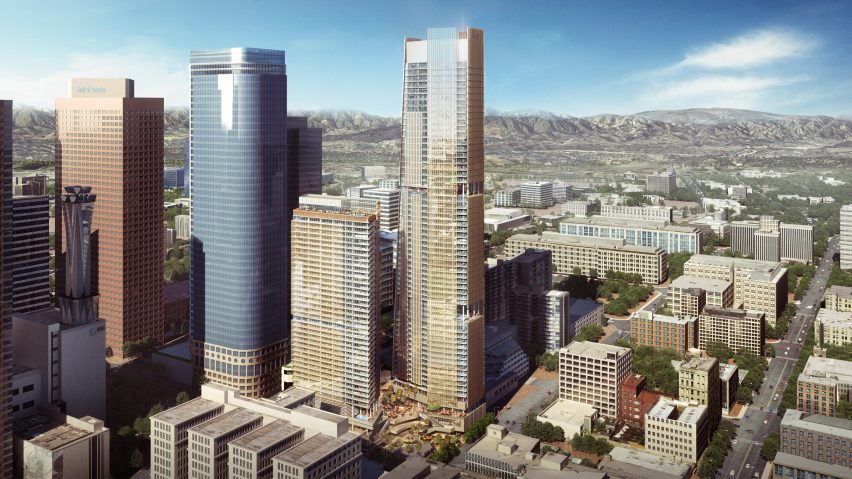US studio Handel Architects has designed the Angels Landing skyscraper in Los Angeles, which will be the third tallest building in the city.
Set to be built on a site between Hill Street and California Plaza in Downtown Los Angeles, the development will have two mixed-use towers, street-front retail and restaurants, as well as a multi-storey outdoor park that integrates Angel's Flight, a trolley built in 1901.
The tallest of the towers will be 854 feet tall (260 metres) with 88 floors 63 above ground – and the smaller will be 494 feet tall (150 metres).
This will make it the third tallest building in Los Angeles. The developers The Peebles Corporation and MacFarlane Partners, – both minority-owned firms – also claim it will be the largest building in the US built by Black developers.
"Angels Landing is the largest development to be built by Black developers in the United States, marking a milestone not only for the real estate industry but the future of Los Angeles and the country at large," said the developers in a release.
According to Handel Architects founder Gary Handel, the structure will be a sort of "wayfinder" that uses the high visibility on the skyline to indicate the location of the public space at the base.
The towers will rest on a podium that holds the entrances to the hotel and retail and extends outside connecting the two towers with an open-air public space that terraces up between the building, connecting the different elements.
The terrace's sculptural concrete massing will terminate at California Plaza, an existing park that Angels Landing expands and integrates into the outdoor public space.
"Over 56,000 square feet of open space on all these different levels create almost a modern interpretation of an Italian hill town," said Handel.
Where the towers meet the podium, massive steel support beams will be exposed down to street level.
A series of vertical louvres will operate as sun shades along the facades. Closer to the ground, around the podium, the louvres will be spaced close together and reflect a more "organic" material palette, though the specific materials for the facade haven't been set, according to Handel.
In the higher sections of the towers, the louvre patterns remain in a series of curtain-wall panels that also provide sun shading while emphasizing the height of the tower.
Breaks in the curtain wall provide increased depth for the balconies.
According to Handel, the interaction of the balconies with the louvres "further articulates the tower and adds a sense of verticality and creates what we think is a handsome composition".
The shorter of the two towers has a "lozenge" shape and a height that the architecture studio called "transitional", in that it ties the height of the buildings around it into the larger tower.
Floor plates will extend out where the edge of the structure meets the entry park, creating fins that provide extra shade for the dwellings below.
The larger tower will be slightly sloped on one side and the facade is broken up by open areas where the exposed beams can be seen again. These junctures will accentuate the slight slope of the tower and provide space for massive covered terraces.
A parapet where the louvres expand past the top of the building will create a crown at the apex of the structure.
US studio Handel Architects previously completed a pair of residential towers alongside the historic Manhattan cathedral in New York and a Jersey City skyscraper with gridded white facades.
The renders are courtesy of Handel Architects.

